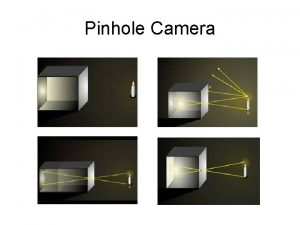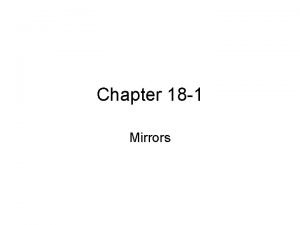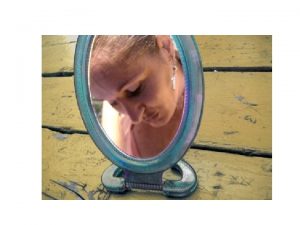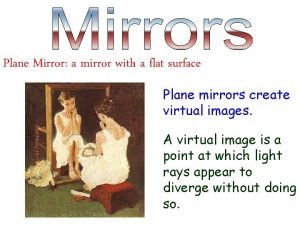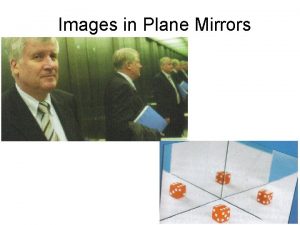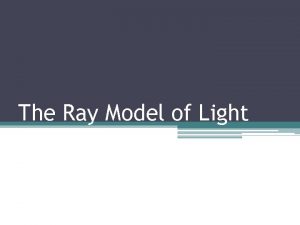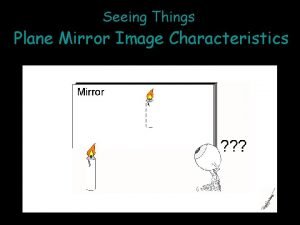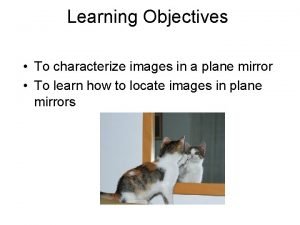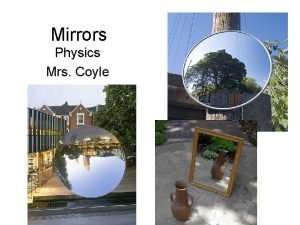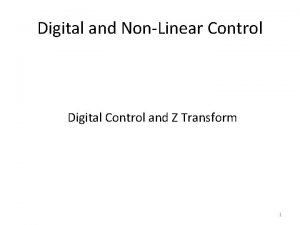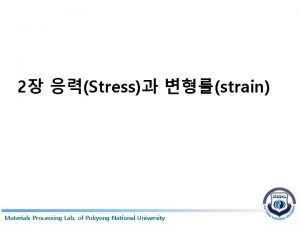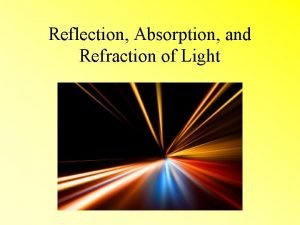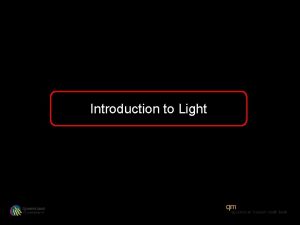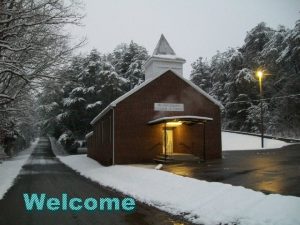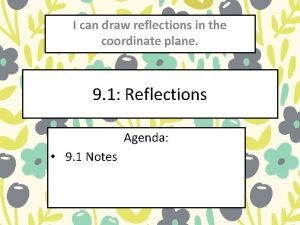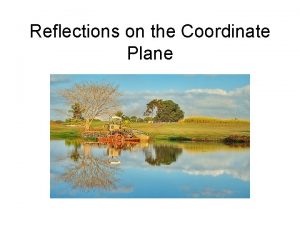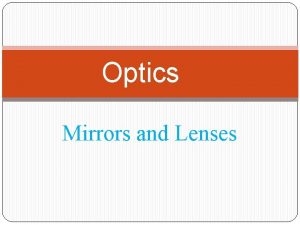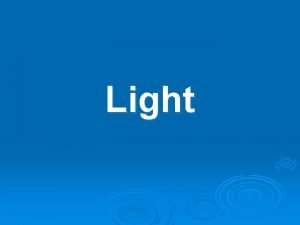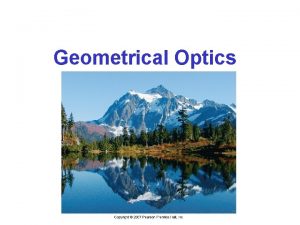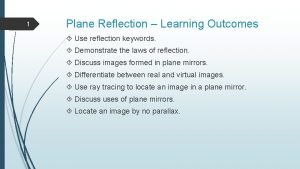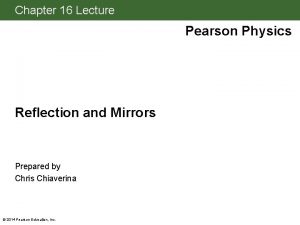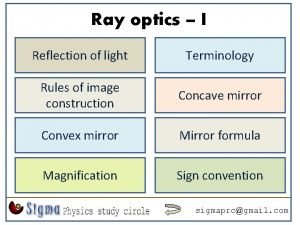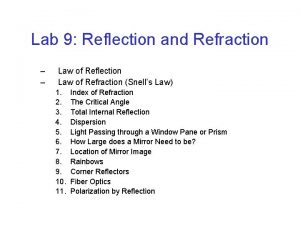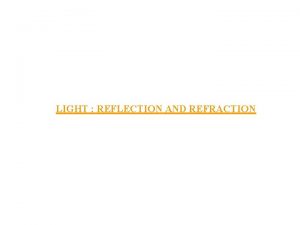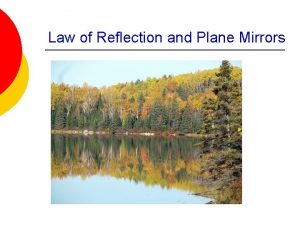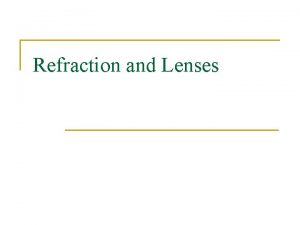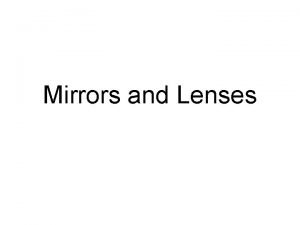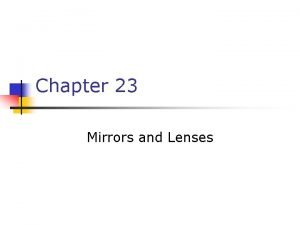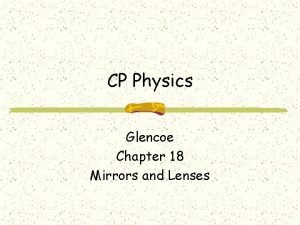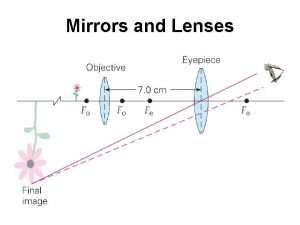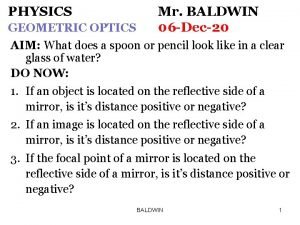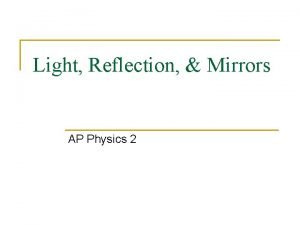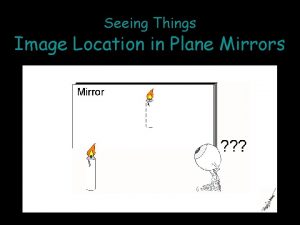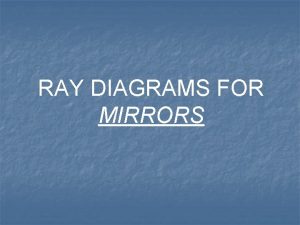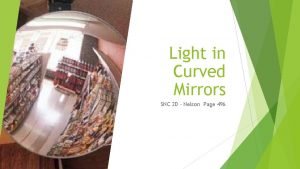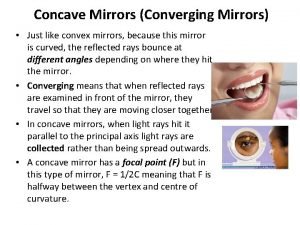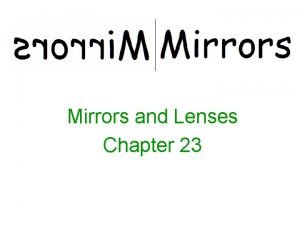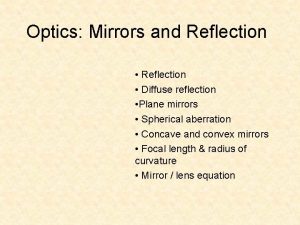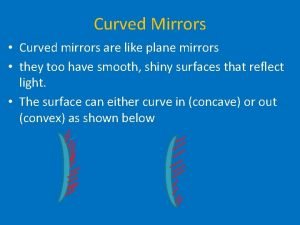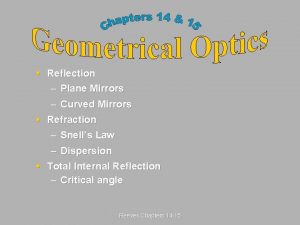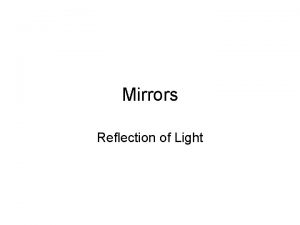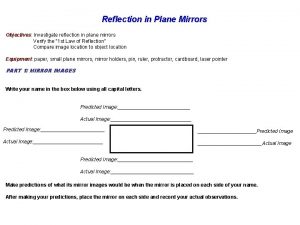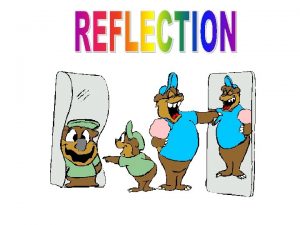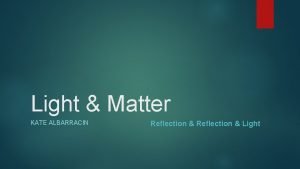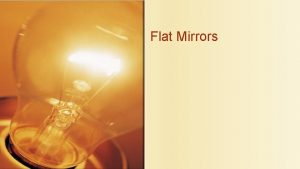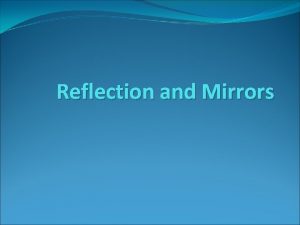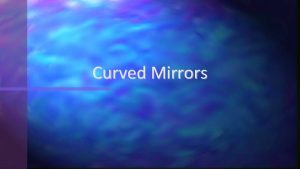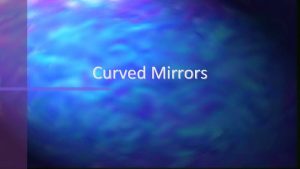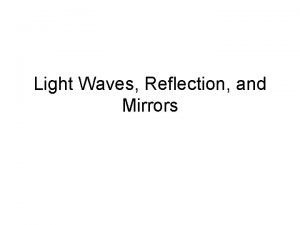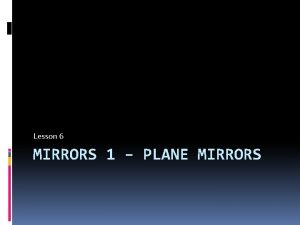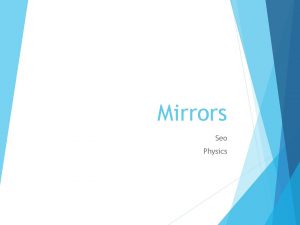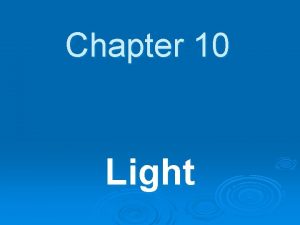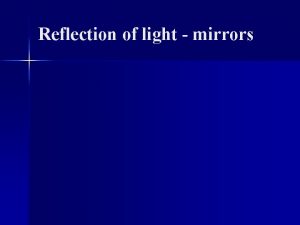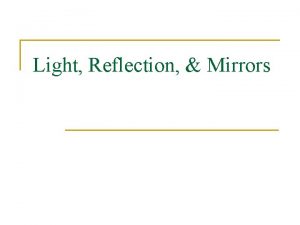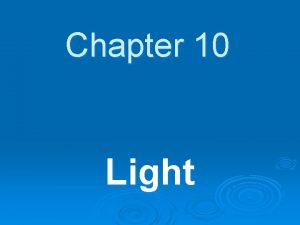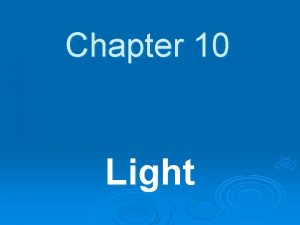Light Reflection and Mirrors Reflection from Plane Mirrors




















































- Slides: 52

Light Reflection and Mirrors

Reflection from Plane Mirrors The Law of Reflection When a wave traveling in two dimensions encounters a barrier, the angle of incidence is equal to the angle of reflection of the wave This same two-dimensional reflection relationship applies to light waves

Reflection from Plane Mirrors The Law of Reflection

Reflection from Plane Mirrors Smooth and Rough Surfaces Consider the beam of light shown. All of the rays in this beam of light reflect off the surface parallel to one another

Reflection from Plane Mirrors Smooth and Rough Surfaces This occurs only if the reflecting surface is not rough on the scale of the wavelength of light Such a surface is considered to be smooth relative to the light Specular reflection is caused by a smooth surface, in which parallel light rays are reflected in parallel

Reflection from Plane Mirrors Smooth and Rough Surfaces The figure shows a beam of light reflecting off a sheet of paper, which has a rough surface. All of the light rays that make up the beam are parallel before striking the surface, but the reflected rays are not parallel

Reflection from Plane Mirrors Smooth and Rough Surfaces Diffuse reflection is caused by the scattering of light off a rough surface The law of reflection applies to both smooth and rough surfaces For a rough surface, the angle that each incident ray makes with the normal equals the angle that its reflected ray makes with the normal

Reflection from Plane Mirrors Objects and Plane-Mirror Images A plane mirror is a flat, smooth surface from which light is reflected by specular reflection To understand reflection from a mirror, you must consider the object of the reflection and the type of image that is formed

Reflection from Plane Mirrors Objects and Plane-Mirror Images An object is a source of light rays that are to be reflected by a mirrored surface An object can be a luminous source, such as a lightbulb, or an illuminated source

Reflection from Plane Mirrors Objects and Plane-Mirror Images The combination of the image points produced by reflected light rays forms the image of the bird It is a virtual image, which is a type of image formed by diverging light rays A virtual image is always on the opposite side of the mirror from the object Images of real objects produced by plane mirrors are always virtual images

Reflection from Plane Mirrors Properties of Plane-Mirror Images Looking at yourself in a mirror, you can see that your image appears to be the same distance behind the mirror as you are in front of the mirror You also see that your image is oriented as you are, and it matches your size This is where the expression “mirror image” originates If you move toward the mirror, your image moves toward the mirror. If you move away, your image also moves away

Reflection from Plane Mirrors Image Position and Height The geometric model in the figure below demonstrates why the distances are the same Two rays from point O at the tip of the candle strike the mirror at point P 1 and point P 2, respectively

Reflection from Plane Mirrors Image Position and Height Both rays are reflected according to the law of reflection The reflected rays are extended behind the mirror as sight lines, converging at point I, which is the image of point O

Reflection from Plane Mirrors Image Position and Height Ray 1, which strikes the mirror at an angle of incidence of 0°, is reflected back on itself, so the sight line is at 90° to the mirror, just as ray 1

Reflection from Plane Mirrors Image Position and Height Ray 2 is also reflected at an angle equal to the angle of incidence, so the sight line is at the same angle to the mirror as ray 2

Reflection from Plane Mirrors Image Position and Height Using the convention that image position is negative to indicate that the image is virtual, the following is true With a plane mirror, the image position is equal to the negative of the object position. The negative sign indicates that the image is virtual Plane-Mirror Image Position

Reflection from Plane Mirrors Image Position and Height You can draw rays from the object to the mirror to determine the size of the image The sight lines of two rays originating from the bottom of the candle in the figure will converge at the bottom of the image

Reflection from Plane Mirrors Image Position and Height Using the law of reflection and congruent-triangle geometry, the following is true of the object height, ho, and image height, hi, and any other dimension of the object and image With a plane mirror, image height is equal to object height Plane-Mirror Image Height

Curved Mirrors Concave Mirrors A concave mirror has a reflective surface, the edges of which curve toward the observer Properties of a concave mirror depend on how much it is curved

Curved Mirrors Concave Mirrors The figure below shows how a spherical concave mirror works In a spherical concave mirror, the mirror is shaped as if it were a section of a hollow sphere with an inner reflective surface The mirror has the same geometric center, C, and radius of curvature, r, as a sphere of radius, r

Curved Mirrors Concave Mirrors The line that passes through line segment CM is the principal axis, which is the straight line perpendicular to the surface of the mirror that divides the mirror in half Point M is the center of the mirror where the principal axis intersects the mirror

Curved Mirrors Concave Mirrors When a ray strikes a mirror, it is reflected according to the law of reflection The figure shows that a ray parallel to the principal axis is reflected and crosses the principal axis at point F, the focal point

Curved Mirrors Concave Mirrors F is at the halfway point between M and C The focal length, f, is the position of the focal point with respect to a mirror along the principal axis and can be expressed as f = r/2 The focal length is positive for a concave mirror

Curved Mirrors Graphical Method of Finding the Image

Curved Mirrors Graphical Method of Finding the Image To more easily understand how ray tracing works with curved mirrors, you can use simple, one-dimensional objects, such as the arrow shown in the figure

Curved Mirrors Graphical Method of Finding the Image A concave mirror produces an inverted real image if the object position, do, is greater than twice the focal length, f The object is then beyond the center of curvature, C

Curved Mirrors Graphical Method of Finding the Image If the object is placed between the center of curvature and the focal point, F, as shown in the figure, the image is again real and inverted However, the size of the image is now greater than the size of the object

Curved Mirrors Graphical Method of Finding the Image How can the inverted real image created by a concave mirror be turned right-side up? In 1663, Scottish astronomer James Gregory developed the Gregorian telescope, to resolve this problem.

Curved Mirrors Graphical Method of Finding the Image It is composed of a large concave mirror and a small concave mirror arranged such that the smaller mirror is outside of the focal point of the larger mirror Parallel rays of light from distant objects strike the larger mirror and reflect toward the smaller mirror

Curved Mirrors Graphical Method of Finding the Image The rays then reflect off the smaller mirror and form a real image that is oriented exactly as the object is

Curved Mirrors Real Image Defects in Concave Mirrors In tracing rays, you have reflected the rays from the principal plane, which is a vertical line representing the mirror In reality, rays are reflected off the mirror itself, as shown in the figure Notice that only parallel rays that are close to the principal axis, or paraxial rays, are reflected through the focal point Other rays converge at points closer to the mirror

Curved Mirrors Real Image Defects in Concave Mirrors The image formed by parallel rays reflecting off a spherical mirror with a large mirror diameter and a small radius of curvature is a disk, not a point This effect, called spherical aberration, makes an image look fuzzy, not sharp

Curved Mirrors Graphical Method of Finding the Image A mirror ground to the shape of a parabola, as in this figure, suffers no spherical aberration Because of the cost of manufacturing large, perfectly parabolic mirrors, many of the newest telescopes use spherical mirrors and smaller, specially-designed secondary mirrors or lenses to correct for spherical aberration

Curved Mirrors Graphical Method of Finding the Image Spherical aberration is reduced as the ratio of the mirror’s diameter, shown below, to its radius of curvature is reduced Thus, lower-cost spherical mirrors can be used in lower-precision applications

Curved Mirrors Mathematical Method of Locating the Image The spherical mirror model can be used to develop a simple equation for spherical mirrors You must use the paraxial ray approximation, which states that only rays that are close to and almost parallel with the principal axis are used to form an image Using this, in combination with the law of reflection, leads to the mirror equation, relating the focal length, f, object position, do, and image position, di, of a spherical mirror

Curved Mirrors Mathematical Method of Locating the Image The reciprocal of the focal length of a spherical mirror is equal to the sum of the reciprocals of the image position and the object position Mirror Equation

Curved Mirrors Magnification is a property of spherical mirrors which refers to how much larger or smaller an image is relative to the object The magnification of an object by a spherical mirror, defined as the image height divided by the object height, is equal to the negative of the image position, divided by the object distance Magnification

Curved Mirrors Magnification If the object is beyond point C, the absolute value of the magnification for the real image is less than 1 This means that the image is smaller than the object If the object is placed between point C and point F, the absolute value of the magnification for the real image is greater than 1 Thus, the image is larger than the object

Curved Mirrors Convex Mirrors The inner surface of a shiny spoon acts as a concave mirror If you turn the spoon around, the outer surface acts as a convex mirror, a reflective surface with edges that curve away from the observer

Curved Mirrors Convex Mirrors Properties of a spherical convex mirror are shown in the figure

Curved Mirrors Convex Mirrors Rays reflected from a convex mirror always diverge. Thus, convex mirrors form virtual images Points F and C are behind the mirror

Curved Mirrors Convex Mirrors In the mirror equation, f and di are negative numbers because they are both behind the mirror

Curved Mirrors Convex Mirrors The ray diagram in the figure represents how an image is formed by a convex mirror

Curved Mirrors Convex Mirrors The figure uses two rays, but remember that there an infinite number of rays Ray 1 approaches the mirror parallel to the principal axis

Curved Mirrors Convex Mirrors The reflected ray is drawn along a sight line from F through the point where ray 1 strikes the mirror Ray 2 approaches the mirror on a path that, if extended behind the mirror, would pass through F

Curved Mirrors Convex Mirrors The reflected part of ray 2 and its sight line are parallel to the principal axis The two reflected rays diverge, and the sight lines intersect behind the mirror at the location of the image

Curved Mirrors Convex Mirrors An image produced by a single convex mirror is always a virtual image that is upright and smaller than the object The magnification equation is useful for determining the apparent dimensions of an object as seen in a spherical convex mirror

Curved Mirrors Convex Mirrors If you know the diameter of an object, you can multiply by the magnification fraction to see how the diameter changes You will find that the diameter is smaller, as are all other dimensions This is why the objects appear to be farther away than they actually are for convex mirrors

Curved Mirrors Field of View By forming smaller images, convex mirrors enlarge the area, or field of view, that an observer sees, as shown in the figure The center of this field of view is visible from any angle of an observer off the principal axis of the mirror; thus, the field of view is visible from a wide perspective For this reason, convex mirrors often are used in cars as passenger-side rearview mirrors

Curved Mirrors Mirror Comparison The table compares the properties of single-mirror systems

Curved Mirrors Mirror Comparison Virtual images are always behind the mirror, which means that the image position is negative When the absolute value of a magnification is between zero and one, the image is smaller than the object A negative magnification means the image is inverted relative to the object

Curved Mirrors Mirror Comparison Notice that the single plane mirror and convex mirror produce only virtual images, whereas the concave mirror can produce real images or virtual images Plane mirrors give simple reflections, and convex mirrors expand the field of view A concave mirror acts as a magnifier when an object is within the focal length of the mirror
 Software-defined networking: a comprehensive survey
Software-defined networking: a comprehensive survey Pinhole camera reflection
Pinhole camera reflection Is flat, smooth mirror.
Is flat, smooth mirror. Chapter 17 reflection and mirrors
Chapter 17 reflection and mirrors Physics
Physics Light light light chapter 23
Light light light chapter 23 Into the light chapter 22
Into the light chapter 22 Light light light chapter 22
Light light light chapter 22 A plane mirror is a flat surface
A plane mirror is a flat surface Salt acronym mirrors
Salt acronym mirrors Name the two parts that make up most mirrors
Name the two parts that make up most mirrors Salt characteristics of a plane mirror
Salt characteristics of a plane mirror All images in plane mirrors are apex
All images in plane mirrors are apex Di and do physics
Di and do physics Mpls control plane and data plane
Mpls control plane and data plane Inverse z-transform solved examples
Inverse z-transform solved examples 포아송비
포아송비 Reflection refraction transmission and absorption of light
Reflection refraction transmission and absorption of light Introduction of light
Introduction of light Salt and light reflection
Salt and light reflection Cuboid line of symmetry
Cuboid line of symmetry Reflection on coordinate plane
Reflection on coordinate plane How many unit
How many unit Plano convex lens
Plano convex lens Who says put out the light and then put out the light
Who says put out the light and then put out the light Distinguish between photosystem 1 and photosystem 2
Distinguish between photosystem 1 and photosystem 2 It is the bouncing off of light
It is the bouncing off of light Reflection light analogy
Reflection light analogy Light reflection color
Light reflection color What is mirror formula
What is mirror formula Plane mirror used
Plane mirror used Reflection of light
Reflection of light Reflection of light example
Reflection of light example Reflection
Reflection Lab 9
Lab 9 Image formed by convex mirror when object is at infinity
Image formed by convex mirror when object is at infinity Characteristics of light
Characteristics of light Define reflection of light
Define reflection of light Material that blocks light
Material that blocks light Mirror and lens equation
Mirror and lens equation Mirrors and lenses
Mirrors and lenses Mirrors and lenses
Mirrors and lenses Physics classroom lenses and mirrors
Physics classroom lenses and mirrors A light ray traveling obliquely to a convex mirror axis
A light ray traveling obliquely to a convex mirror axis Site:slidetodoc.com
Site:slidetodoc.com Ap physics 2 mirrors and lenses
Ap physics 2 mirrors and lenses Flat plate collector with adjustable mirrors
Flat plate collector with adjustable mirrors Seeing things in the mirror
Seeing things in the mirror Ray diagrams for mirrors
Ray diagrams for mirrors Curved mirrors worksheet
Curved mirrors worksheet Salt for concave mirrors
Salt for concave mirrors Elisabetta silli
Elisabetta silli Concave mirrors can produce
Concave mirrors can produce

